Report on Church Observation: Rituals, Religiosity, and Demographics
VerifiedAdded on 2022/09/14
|11
|2811
|16
Report
AI Summary
This report presents an analysis of observations conducted at St. Patrick's Cathedral in Melbourne, Australia. The study examines the church's rituals, religiosity, and the impact of these factors on the changing demographics and attendance patterns. The author employs secularization theory to interpret the findings, investigating the strengths and weaknesses of the observed practices and rituals. The report includes a literature review on Christianity in Australia, its historical context, and the current religious landscape. The methodology involves a mixed-method approach, primarily qualitative, with observations and interviews conducted at St. Patrick's Cathedral. The findings reveal shifts in the church's demographics and highlight the evolving nature of religious practices. The discussion explores the influence of rituals on youth engagement and the broader implications for the church's role in society. The report concludes with the author's reflections on the observed phenomena and their significance.
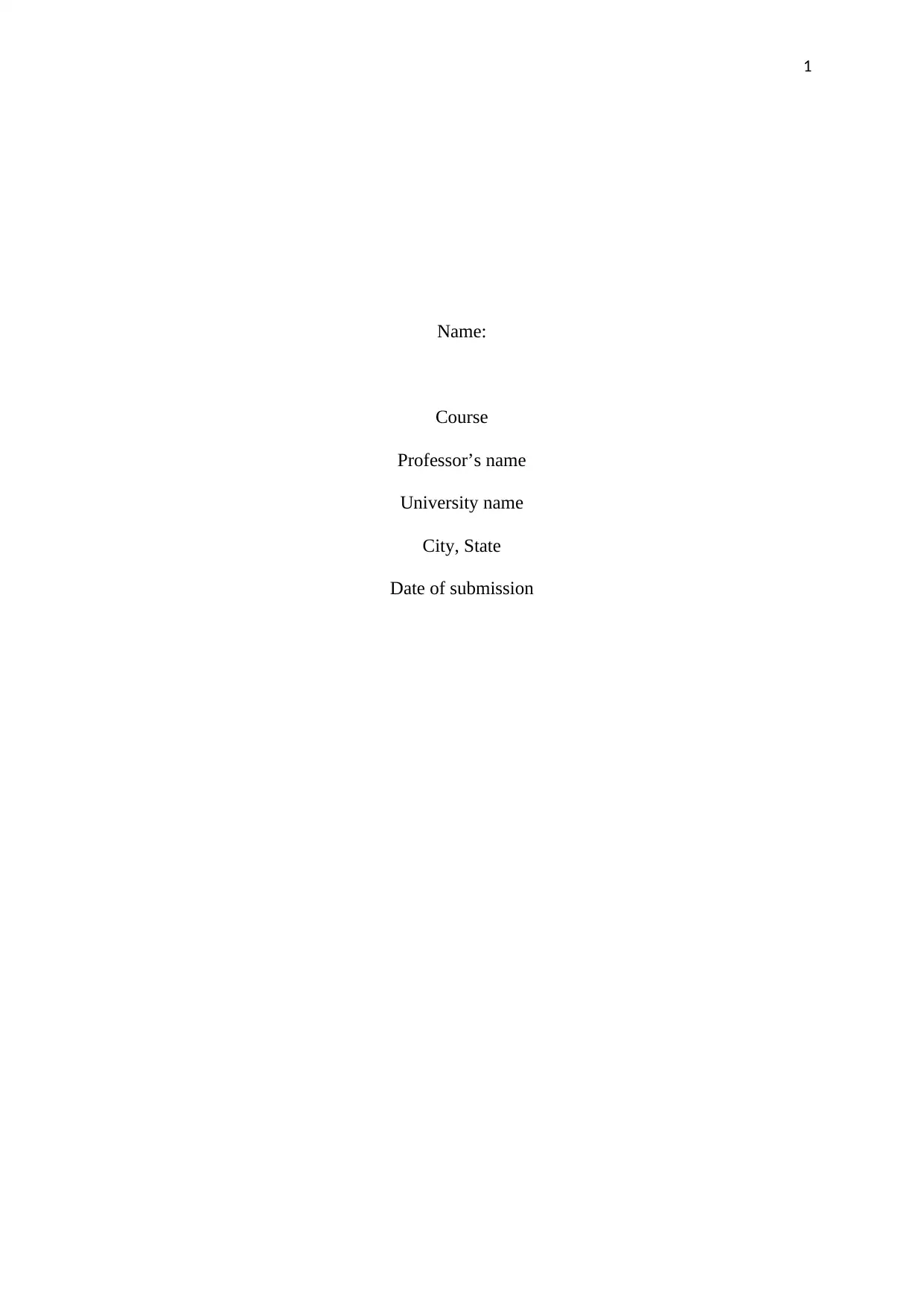
1
Name:
Course
Professor’s name
University name
City, State
Date of submission
Name:
Course
Professor’s name
University name
City, State
Date of submission
Paraphrase This Document
Need a fresh take? Get an instant paraphrase of this document with our AI Paraphraser
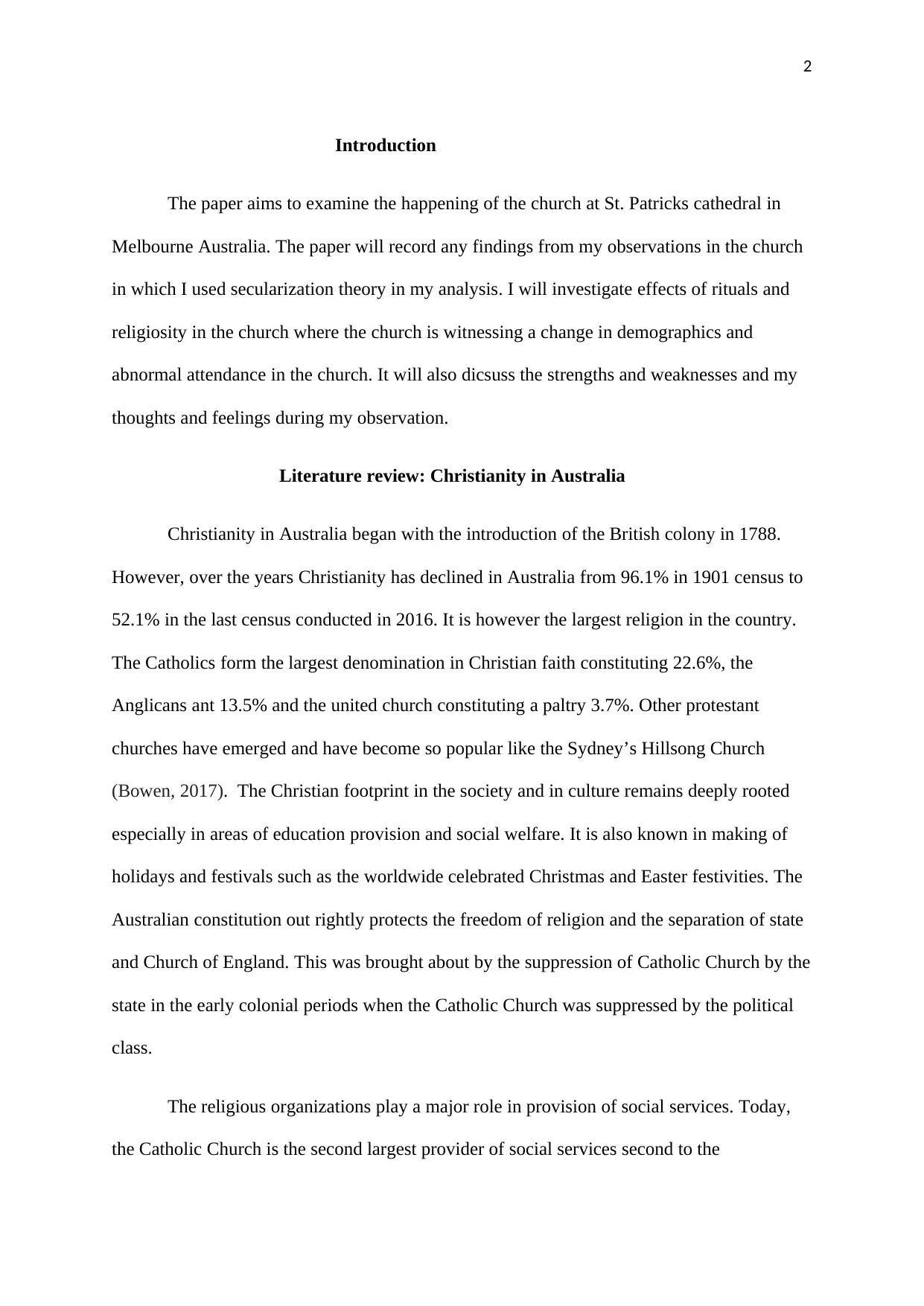
2
Introduction
The paper aims to examine the happening of the church at St. Patricks cathedral in
Melbourne Australia. The paper will record any findings from my observations in the church
in which I used secularization theory in my analysis. I will investigate effects of rituals and
religiosity in the church where the church is witnessing a change in demographics and
abnormal attendance in the church. It will also dicsuss the strengths and weaknesses and my
thoughts and feelings during my observation.
Literature review: Christianity in Australia
Christianity in Australia began with the introduction of the British colony in 1788.
However, over the years Christianity has declined in Australia from 96.1% in 1901 census to
52.1% in the last census conducted in 2016. It is however the largest religion in the country.
The Catholics form the largest denomination in Christian faith constituting 22.6%, the
Anglicans ant 13.5% and the united church constituting a paltry 3.7%. Other protestant
churches have emerged and have become so popular like the Sydney’s Hillsong Church
(Bowen, 2017). The Christian footprint in the society and in culture remains deeply rooted
especially in areas of education provision and social welfare. It is also known in making of
holidays and festivals such as the worldwide celebrated Christmas and Easter festivities. The
Australian constitution out rightly protects the freedom of religion and the separation of state
and Church of England. This was brought about by the suppression of Catholic Church by the
state in the early colonial periods when the Catholic Church was suppressed by the political
class.
The religious organizations play a major role in provision of social services. Today,
the Catholic Church is the second largest provider of social services second to the
Introduction
The paper aims to examine the happening of the church at St. Patricks cathedral in
Melbourne Australia. The paper will record any findings from my observations in the church
in which I used secularization theory in my analysis. I will investigate effects of rituals and
religiosity in the church where the church is witnessing a change in demographics and
abnormal attendance in the church. It will also dicsuss the strengths and weaknesses and my
thoughts and feelings during my observation.
Literature review: Christianity in Australia
Christianity in Australia began with the introduction of the British colony in 1788.
However, over the years Christianity has declined in Australia from 96.1% in 1901 census to
52.1% in the last census conducted in 2016. It is however the largest religion in the country.
The Catholics form the largest denomination in Christian faith constituting 22.6%, the
Anglicans ant 13.5% and the united church constituting a paltry 3.7%. Other protestant
churches have emerged and have become so popular like the Sydney’s Hillsong Church
(Bowen, 2017). The Christian footprint in the society and in culture remains deeply rooted
especially in areas of education provision and social welfare. It is also known in making of
holidays and festivals such as the worldwide celebrated Christmas and Easter festivities. The
Australian constitution out rightly protects the freedom of religion and the separation of state
and Church of England. This was brought about by the suppression of Catholic Church by the
state in the early colonial periods when the Catholic Church was suppressed by the political
class.
The religious organizations play a major role in provision of social services. Today,
the Catholic Church is the second largest provider of social services second to the
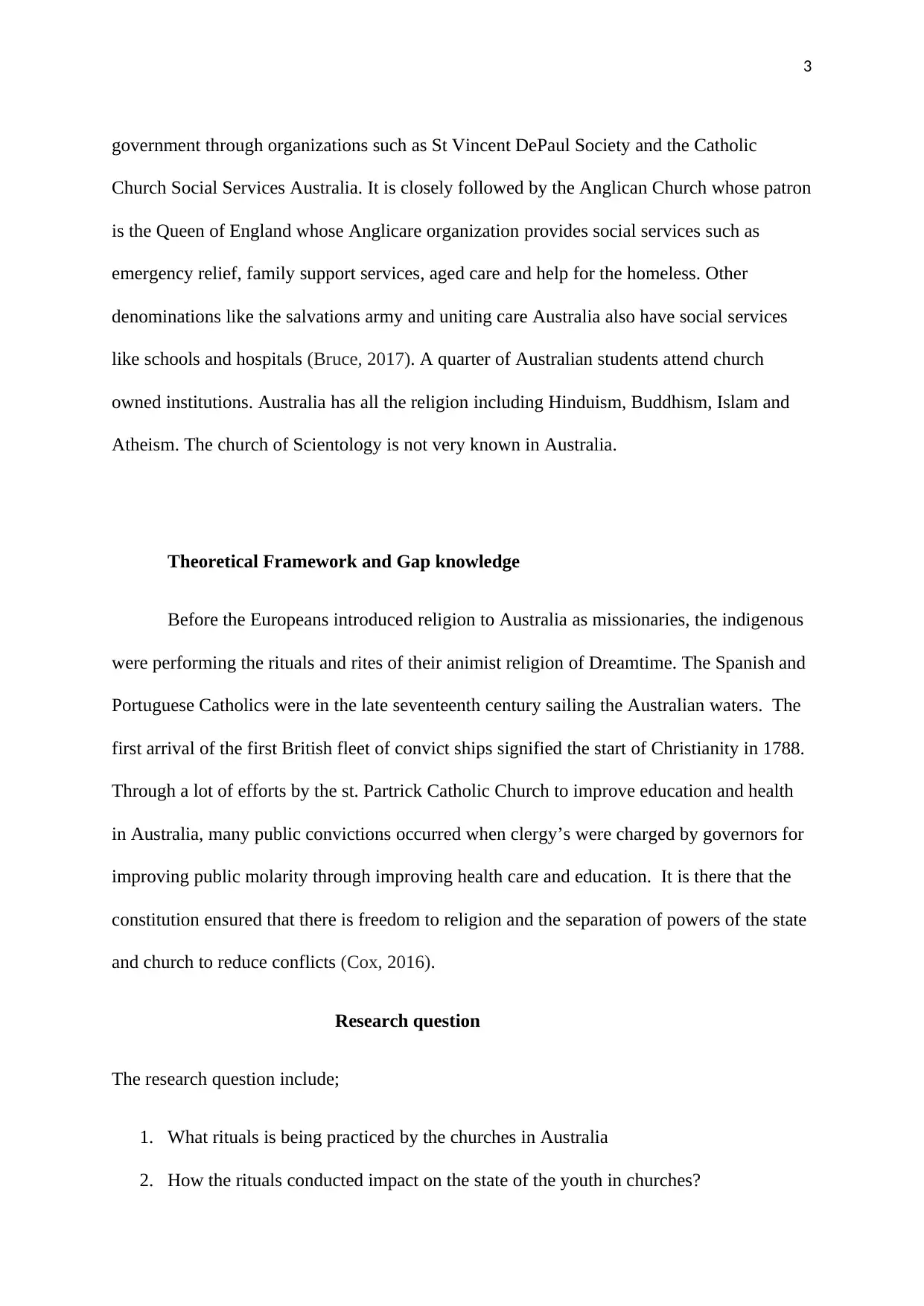
3
government through organizations such as St Vincent DePaul Society and the Catholic
Church Social Services Australia. It is closely followed by the Anglican Church whose patron
is the Queen of England whose Anglicare organization provides social services such as
emergency relief, family support services, aged care and help for the homeless. Other
denominations like the salvations army and uniting care Australia also have social services
like schools and hospitals (Bruce, 2017). A quarter of Australian students attend church
owned institutions. Australia has all the religion including Hinduism, Buddhism, Islam and
Atheism. The church of Scientology is not very known in Australia.
Theoretical Framework and Gap knowledge
Before the Europeans introduced religion to Australia as missionaries, the indigenous
were performing the rituals and rites of their animist religion of Dreamtime. The Spanish and
Portuguese Catholics were in the late seventeenth century sailing the Australian waters. The
first arrival of the first British fleet of convict ships signified the start of Christianity in 1788.
Through a lot of efforts by the st. Partrick Catholic Church to improve education and health
in Australia, many public convictions occurred when clergy’s were charged by governors for
improving public molarity through improving health care and education. It is there that the
constitution ensured that there is freedom to religion and the separation of powers of the state
and church to reduce conflicts (Cox, 2016).
Research question
The research question include;
1. What rituals is being practiced by the churches in Australia
2. How the rituals conducted impact on the state of the youth in churches?
government through organizations such as St Vincent DePaul Society and the Catholic
Church Social Services Australia. It is closely followed by the Anglican Church whose patron
is the Queen of England whose Anglicare organization provides social services such as
emergency relief, family support services, aged care and help for the homeless. Other
denominations like the salvations army and uniting care Australia also have social services
like schools and hospitals (Bruce, 2017). A quarter of Australian students attend church
owned institutions. Australia has all the religion including Hinduism, Buddhism, Islam and
Atheism. The church of Scientology is not very known in Australia.
Theoretical Framework and Gap knowledge
Before the Europeans introduced religion to Australia as missionaries, the indigenous
were performing the rituals and rites of their animist religion of Dreamtime. The Spanish and
Portuguese Catholics were in the late seventeenth century sailing the Australian waters. The
first arrival of the first British fleet of convict ships signified the start of Christianity in 1788.
Through a lot of efforts by the st. Partrick Catholic Church to improve education and health
in Australia, many public convictions occurred when clergy’s were charged by governors for
improving public molarity through improving health care and education. It is there that the
constitution ensured that there is freedom to religion and the separation of powers of the state
and church to reduce conflicts (Cox, 2016).
Research question
The research question include;
1. What rituals is being practiced by the churches in Australia
2. How the rituals conducted impact on the state of the youth in churches?
⊘ This is a preview!⊘
Do you want full access?
Subscribe today to unlock all pages.

Trusted by 1+ million students worldwide
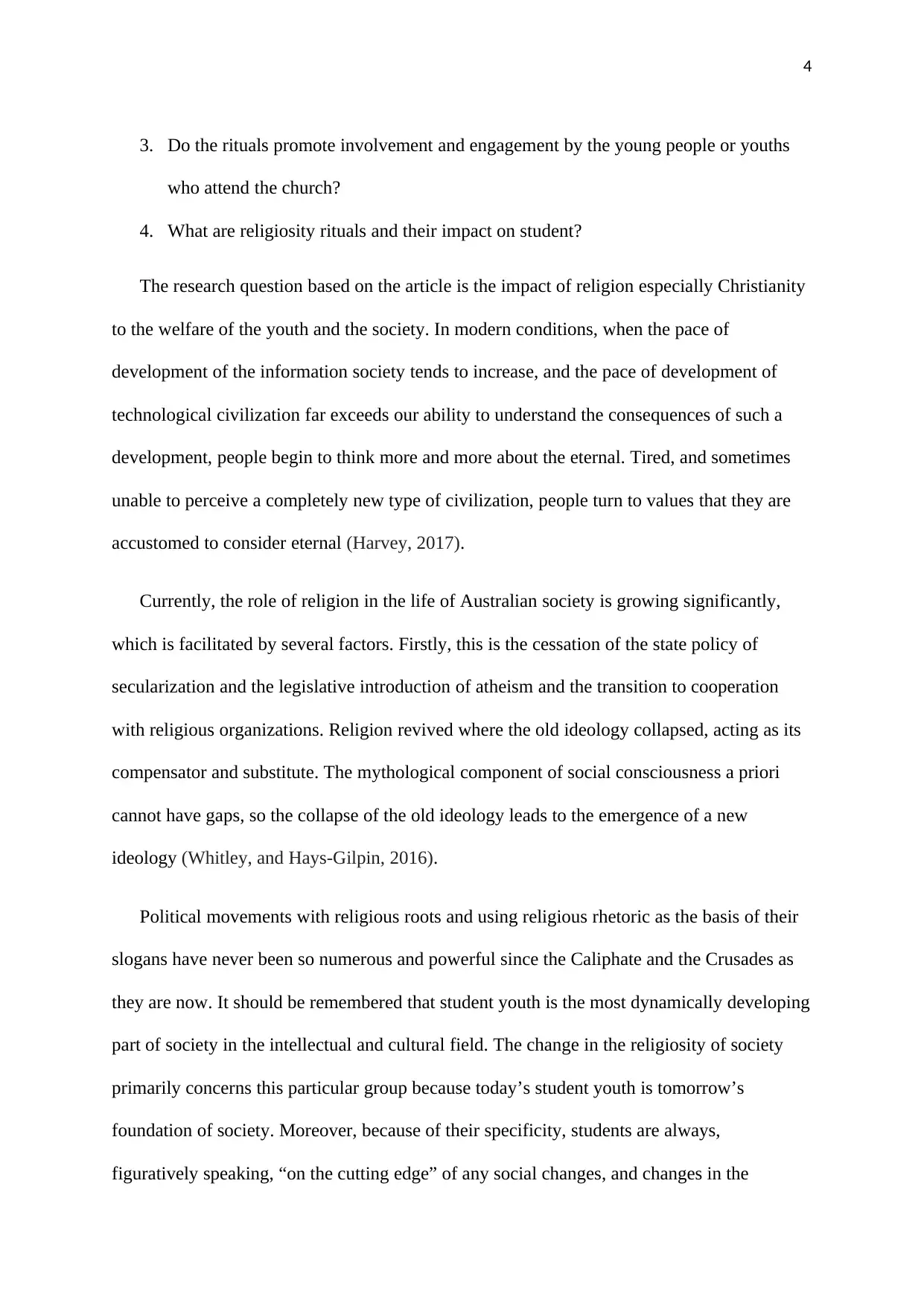
4
3. Do the rituals promote involvement and engagement by the young people or youths
who attend the church?
4. What are religiosity rituals and their impact on student?
The research question based on the article is the impact of religion especially Christianity
to the welfare of the youth and the society. In modern conditions, when the pace of
development of the information society tends to increase, and the pace of development of
technological civilization far exceeds our ability to understand the consequences of such a
development, people begin to think more and more about the eternal. Tired, and sometimes
unable to perceive a completely new type of civilization, people turn to values that they are
accustomed to consider eternal (Harvey, 2017).
Currently, the role of religion in the life of Australian society is growing significantly,
which is facilitated by several factors. Firstly, this is the cessation of the state policy of
secularization and the legislative introduction of atheism and the transition to cooperation
with religious organizations. Religion revived where the old ideology collapsed, acting as its
compensator and substitute. The mythological component of social consciousness a priori
cannot have gaps, so the collapse of the old ideology leads to the emergence of a new
ideology (Whitley, and Hays-Gilpin, 2016).
Political movements with religious roots and using religious rhetoric as the basis of their
slogans have never been so numerous and powerful since the Caliphate and the Crusades as
they are now. It should be remembered that student youth is the most dynamically developing
part of society in the intellectual and cultural field. The change in the religiosity of society
primarily concerns this particular group because today’s student youth is tomorrow’s
foundation of society. Moreover, because of their specificity, students are always,
figuratively speaking, “on the cutting edge” of any social changes, and changes in the
3. Do the rituals promote involvement and engagement by the young people or youths
who attend the church?
4. What are religiosity rituals and their impact on student?
The research question based on the article is the impact of religion especially Christianity
to the welfare of the youth and the society. In modern conditions, when the pace of
development of the information society tends to increase, and the pace of development of
technological civilization far exceeds our ability to understand the consequences of such a
development, people begin to think more and more about the eternal. Tired, and sometimes
unable to perceive a completely new type of civilization, people turn to values that they are
accustomed to consider eternal (Harvey, 2017).
Currently, the role of religion in the life of Australian society is growing significantly,
which is facilitated by several factors. Firstly, this is the cessation of the state policy of
secularization and the legislative introduction of atheism and the transition to cooperation
with religious organizations. Religion revived where the old ideology collapsed, acting as its
compensator and substitute. The mythological component of social consciousness a priori
cannot have gaps, so the collapse of the old ideology leads to the emergence of a new
ideology (Whitley, and Hays-Gilpin, 2016).
Political movements with religious roots and using religious rhetoric as the basis of their
slogans have never been so numerous and powerful since the Caliphate and the Crusades as
they are now. It should be remembered that student youth is the most dynamically developing
part of society in the intellectual and cultural field. The change in the religiosity of society
primarily concerns this particular group because today’s student youth is tomorrow’s
foundation of society. Moreover, because of their specificity, students are always,
figuratively speaking, “on the cutting edge” of any social changes, and changes in the
Paraphrase This Document
Need a fresh take? Get an instant paraphrase of this document with our AI Paraphraser
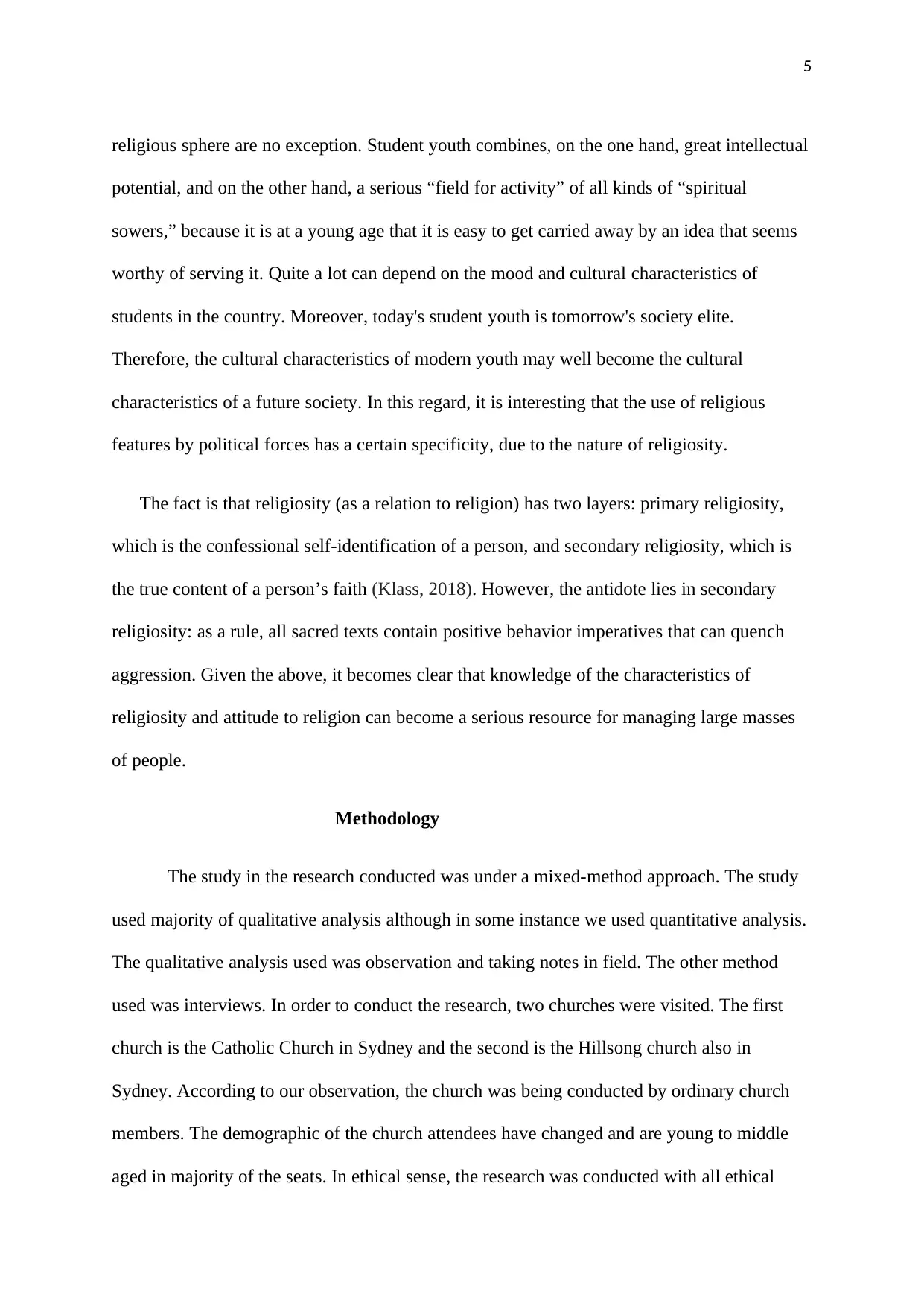
5
religious sphere are no exception. Student youth combines, on the one hand, great intellectual
potential, and on the other hand, a serious “field for activity” of all kinds of “spiritual
sowers,” because it is at a young age that it is easy to get carried away by an idea that seems
worthy of serving it. Quite a lot can depend on the mood and cultural characteristics of
students in the country. Moreover, today's student youth is tomorrow's society elite.
Therefore, the cultural characteristics of modern youth may well become the cultural
characteristics of a future society. In this regard, it is interesting that the use of religious
features by political forces has a certain specificity, due to the nature of religiosity.
The fact is that religiosity (as a relation to religion) has two layers: primary religiosity,
which is the confessional self-identification of a person, and secondary religiosity, which is
the true content of a person’s faith (Klass, 2018). However, the antidote lies in secondary
religiosity: as a rule, all sacred texts contain positive behavior imperatives that can quench
aggression. Given the above, it becomes clear that knowledge of the characteristics of
religiosity and attitude to religion can become a serious resource for managing large masses
of people.
Methodology
The study in the research conducted was under a mixed-method approach. The study
used majority of qualitative analysis although in some instance we used quantitative analysis.
The qualitative analysis used was observation and taking notes in field. The other method
used was interviews. In order to conduct the research, two churches were visited. The first
church is the Catholic Church in Sydney and the second is the Hillsong church also in
Sydney. According to our observation, the church was being conducted by ordinary church
members. The demographic of the church attendees have changed and are young to middle
aged in majority of the seats. In ethical sense, the research was conducted with all ethical
religious sphere are no exception. Student youth combines, on the one hand, great intellectual
potential, and on the other hand, a serious “field for activity” of all kinds of “spiritual
sowers,” because it is at a young age that it is easy to get carried away by an idea that seems
worthy of serving it. Quite a lot can depend on the mood and cultural characteristics of
students in the country. Moreover, today's student youth is tomorrow's society elite.
Therefore, the cultural characteristics of modern youth may well become the cultural
characteristics of a future society. In this regard, it is interesting that the use of religious
features by political forces has a certain specificity, due to the nature of religiosity.
The fact is that religiosity (as a relation to religion) has two layers: primary religiosity,
which is the confessional self-identification of a person, and secondary religiosity, which is
the true content of a person’s faith (Klass, 2018). However, the antidote lies in secondary
religiosity: as a rule, all sacred texts contain positive behavior imperatives that can quench
aggression. Given the above, it becomes clear that knowledge of the characteristics of
religiosity and attitude to religion can become a serious resource for managing large masses
of people.
Methodology
The study in the research conducted was under a mixed-method approach. The study
used majority of qualitative analysis although in some instance we used quantitative analysis.
The qualitative analysis used was observation and taking notes in field. The other method
used was interviews. In order to conduct the research, two churches were visited. The first
church is the Catholic Church in Sydney and the second is the Hillsong church also in
Sydney. According to our observation, the church was being conducted by ordinary church
members. The demographic of the church attendees have changed and are young to middle
aged in majority of the seats. In ethical sense, the research was conducted with all ethical
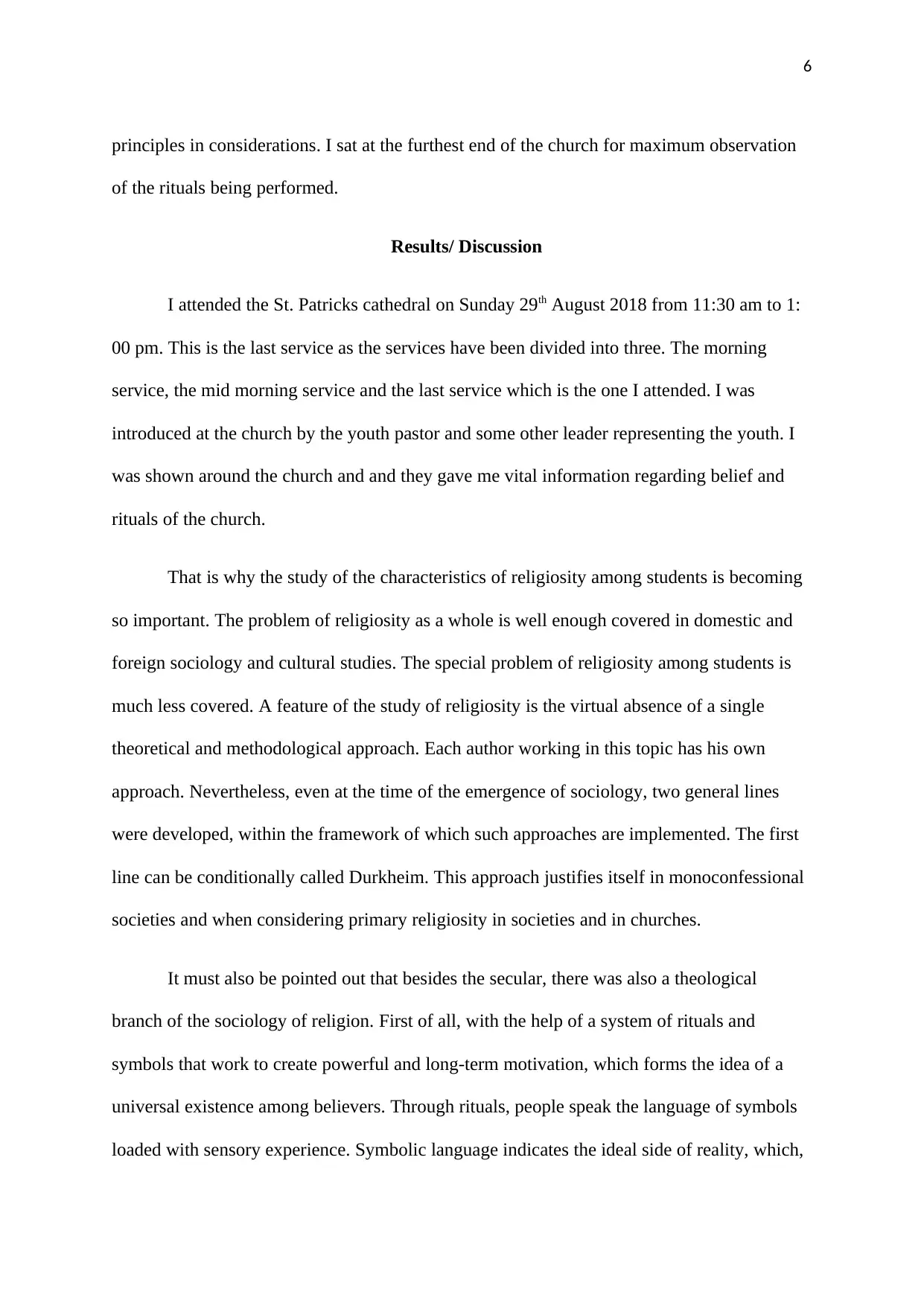
6
principles in considerations. I sat at the furthest end of the church for maximum observation
of the rituals being performed.
Results/ Discussion
I attended the St. Patricks cathedral on Sunday 29th August 2018 from 11:30 am to 1:
00 pm. This is the last service as the services have been divided into three. The morning
service, the mid morning service and the last service which is the one I attended. I was
introduced at the church by the youth pastor and some other leader representing the youth. I
was shown around the church and and they gave me vital information regarding belief and
rituals of the church.
That is why the study of the characteristics of religiosity among students is becoming
so important. The problem of religiosity as a whole is well enough covered in domestic and
foreign sociology and cultural studies. The special problem of religiosity among students is
much less covered. A feature of the study of religiosity is the virtual absence of a single
theoretical and methodological approach. Each author working in this topic has his own
approach. Nevertheless, even at the time of the emergence of sociology, two general lines
were developed, within the framework of which such approaches are implemented. The first
line can be conditionally called Durkheim. This approach justifies itself in monoconfessional
societies and when considering primary religiosity in societies and in churches.
It must also be pointed out that besides the secular, there was also a theological
branch of the sociology of religion. First of all, with the help of a system of rituals and
symbols that work to create powerful and long-term motivation, which forms the idea of a
universal existence among believers. Through rituals, people speak the language of symbols
loaded with sensory experience. Symbolic language indicates the ideal side of reality, which,
principles in considerations. I sat at the furthest end of the church for maximum observation
of the rituals being performed.
Results/ Discussion
I attended the St. Patricks cathedral on Sunday 29th August 2018 from 11:30 am to 1:
00 pm. This is the last service as the services have been divided into three. The morning
service, the mid morning service and the last service which is the one I attended. I was
introduced at the church by the youth pastor and some other leader representing the youth. I
was shown around the church and and they gave me vital information regarding belief and
rituals of the church.
That is why the study of the characteristics of religiosity among students is becoming
so important. The problem of religiosity as a whole is well enough covered in domestic and
foreign sociology and cultural studies. The special problem of religiosity among students is
much less covered. A feature of the study of religiosity is the virtual absence of a single
theoretical and methodological approach. Each author working in this topic has his own
approach. Nevertheless, even at the time of the emergence of sociology, two general lines
were developed, within the framework of which such approaches are implemented. The first
line can be conditionally called Durkheim. This approach justifies itself in monoconfessional
societies and when considering primary religiosity in societies and in churches.
It must also be pointed out that besides the secular, there was also a theological
branch of the sociology of religion. First of all, with the help of a system of rituals and
symbols that work to create powerful and long-term motivation, which forms the idea of a
universal existence among believers. Through rituals, people speak the language of symbols
loaded with sensory experience. Symbolic language indicates the ideal side of reality, which,
⊘ This is a preview!⊘
Do you want full access?
Subscribe today to unlock all pages.

Trusted by 1+ million students worldwide
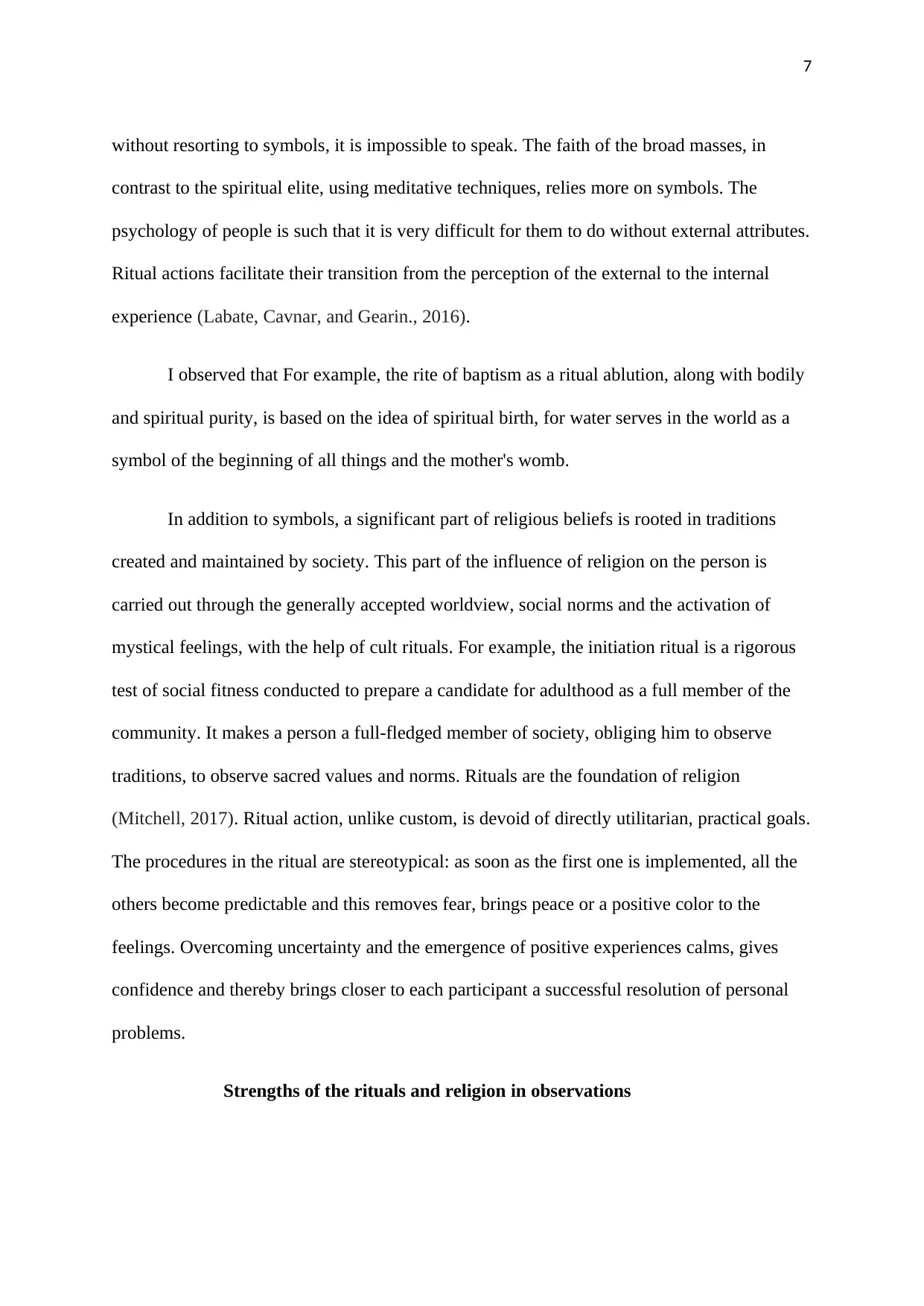
7
without resorting to symbols, it is impossible to speak. The faith of the broad masses, in
contrast to the spiritual elite, using meditative techniques, relies more on symbols. The
psychology of people is such that it is very difficult for them to do without external attributes.
Ritual actions facilitate their transition from the perception of the external to the internal
experience (Labate, Cavnar, and Gearin., 2016).
I observed that For example, the rite of baptism as a ritual ablution, along with bodily
and spiritual purity, is based on the idea of spiritual birth, for water serves in the world as a
symbol of the beginning of all things and the mother's womb.
In addition to symbols, a significant part of religious beliefs is rooted in traditions
created and maintained by society. This part of the influence of religion on the person is
carried out through the generally accepted worldview, social norms and the activation of
mystical feelings, with the help of cult rituals. For example, the initiation ritual is a rigorous
test of social fitness conducted to prepare a candidate for adulthood as a full member of the
community. It makes a person a full-fledged member of society, obliging him to observe
traditions, to observe sacred values and norms. Rituals are the foundation of religion
(Mitchell, 2017). Ritual action, unlike custom, is devoid of directly utilitarian, practical goals.
The procedures in the ritual are stereotypical: as soon as the first one is implemented, all the
others become predictable and this removes fear, brings peace or a positive color to the
feelings. Overcoming uncertainty and the emergence of positive experiences calms, gives
confidence and thereby brings closer to each participant a successful resolution of personal
problems.
Strengths of the rituals and religion in observations
without resorting to symbols, it is impossible to speak. The faith of the broad masses, in
contrast to the spiritual elite, using meditative techniques, relies more on symbols. The
psychology of people is such that it is very difficult for them to do without external attributes.
Ritual actions facilitate their transition from the perception of the external to the internal
experience (Labate, Cavnar, and Gearin., 2016).
I observed that For example, the rite of baptism as a ritual ablution, along with bodily
and spiritual purity, is based on the idea of spiritual birth, for water serves in the world as a
symbol of the beginning of all things and the mother's womb.
In addition to symbols, a significant part of religious beliefs is rooted in traditions
created and maintained by society. This part of the influence of religion on the person is
carried out through the generally accepted worldview, social norms and the activation of
mystical feelings, with the help of cult rituals. For example, the initiation ritual is a rigorous
test of social fitness conducted to prepare a candidate for adulthood as a full member of the
community. It makes a person a full-fledged member of society, obliging him to observe
traditions, to observe sacred values and norms. Rituals are the foundation of religion
(Mitchell, 2017). Ritual action, unlike custom, is devoid of directly utilitarian, practical goals.
The procedures in the ritual are stereotypical: as soon as the first one is implemented, all the
others become predictable and this removes fear, brings peace or a positive color to the
feelings. Overcoming uncertainty and the emergence of positive experiences calms, gives
confidence and thereby brings closer to each participant a successful resolution of personal
problems.
Strengths of the rituals and religion in observations
Paraphrase This Document
Need a fresh take? Get an instant paraphrase of this document with our AI Paraphraser
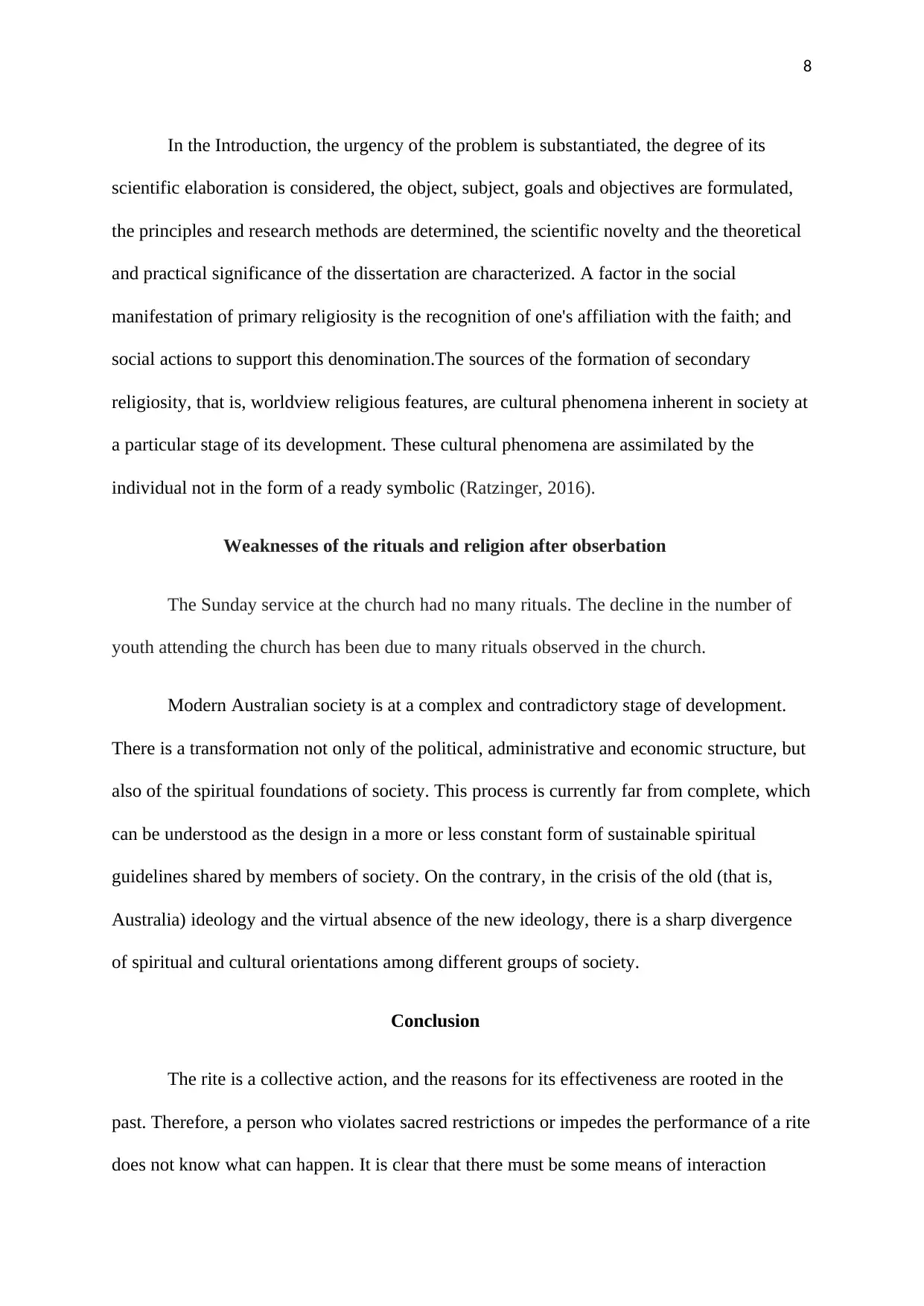
8
In the Introduction, the urgency of the problem is substantiated, the degree of its
scientific elaboration is considered, the object, subject, goals and objectives are formulated,
the principles and research methods are determined, the scientific novelty and the theoretical
and practical significance of the dissertation are characterized. A factor in the social
manifestation of primary religiosity is the recognition of one's affiliation with the faith; and
social actions to support this denomination.The sources of the formation of secondary
religiosity, that is, worldview religious features, are cultural phenomena inherent in society at
a particular stage of its development. These cultural phenomena are assimilated by the
individual not in the form of a ready symbolic (Ratzinger, 2016).
Weaknesses of the rituals and religion after obserbation
The Sunday service at the church had no many rituals. The decline in the number of
youth attending the church has been due to many rituals observed in the church.
Modern Australian society is at a complex and contradictory stage of development.
There is a transformation not only of the political, administrative and economic structure, but
also of the spiritual foundations of society. This process is currently far from complete, which
can be understood as the design in a more or less constant form of sustainable spiritual
guidelines shared by members of society. On the contrary, in the crisis of the old (that is,
Australia) ideology and the virtual absence of the new ideology, there is a sharp divergence
of spiritual and cultural orientations among different groups of society.
Conclusion
The rite is a collective action, and the reasons for its effectiveness are rooted in the
past. Therefore, a person who violates sacred restrictions or impedes the performance of a rite
does not know what can happen. It is clear that there must be some means of interaction
In the Introduction, the urgency of the problem is substantiated, the degree of its
scientific elaboration is considered, the object, subject, goals and objectives are formulated,
the principles and research methods are determined, the scientific novelty and the theoretical
and practical significance of the dissertation are characterized. A factor in the social
manifestation of primary religiosity is the recognition of one's affiliation with the faith; and
social actions to support this denomination.The sources of the formation of secondary
religiosity, that is, worldview religious features, are cultural phenomena inherent in society at
a particular stage of its development. These cultural phenomena are assimilated by the
individual not in the form of a ready symbolic (Ratzinger, 2016).
Weaknesses of the rituals and religion after obserbation
The Sunday service at the church had no many rituals. The decline in the number of
youth attending the church has been due to many rituals observed in the church.
Modern Australian society is at a complex and contradictory stage of development.
There is a transformation not only of the political, administrative and economic structure, but
also of the spiritual foundations of society. This process is currently far from complete, which
can be understood as the design in a more or less constant form of sustainable spiritual
guidelines shared by members of society. On the contrary, in the crisis of the old (that is,
Australia) ideology and the virtual absence of the new ideology, there is a sharp divergence
of spiritual and cultural orientations among different groups of society.
Conclusion
The rite is a collective action, and the reasons for its effectiveness are rooted in the
past. Therefore, a person who violates sacred restrictions or impedes the performance of a rite
does not know what can happen. It is clear that there must be some means of interaction
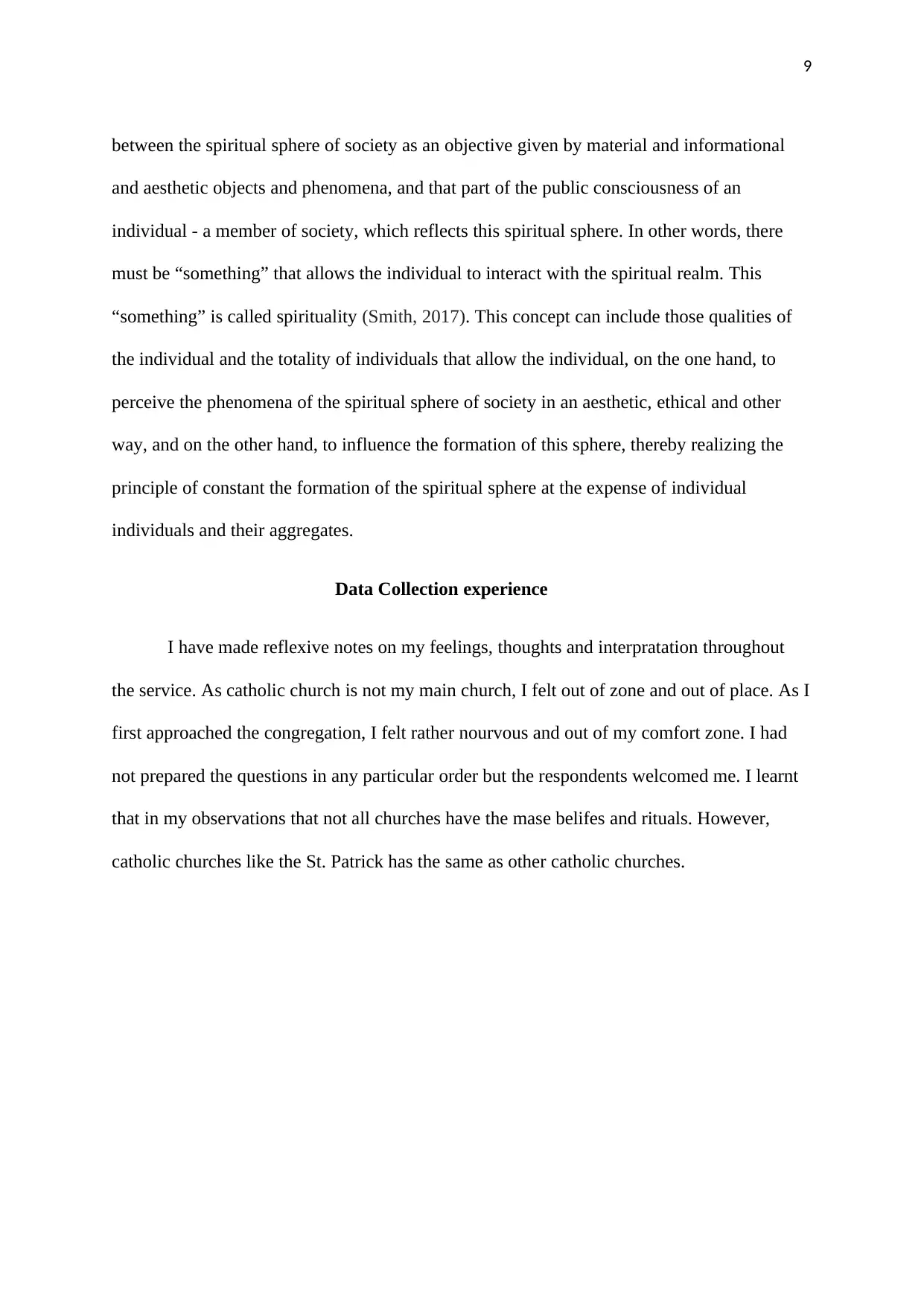
9
between the spiritual sphere of society as an objective given by material and informational
and aesthetic objects and phenomena, and that part of the public consciousness of an
individual - a member of society, which reflects this spiritual sphere. In other words, there
must be “something” that allows the individual to interact with the spiritual realm. This
“something” is called spirituality (Smith, 2017). This concept can include those qualities of
the individual and the totality of individuals that allow the individual, on the one hand, to
perceive the phenomena of the spiritual sphere of society in an aesthetic, ethical and other
way, and on the other hand, to influence the formation of this sphere, thereby realizing the
principle of constant the formation of the spiritual sphere at the expense of individual
individuals and their aggregates.
Data Collection experience
I have made reflexive notes on my feelings, thoughts and interpratation throughout
the service. As catholic church is not my main church, I felt out of zone and out of place. As I
first approached the congregation, I felt rather nourvous and out of my comfort zone. I had
not prepared the questions in any particular order but the respondents welcomed me. I learnt
that in my observations that not all churches have the mase belifes and rituals. However,
catholic churches like the St. Patrick has the same as other catholic churches.
between the spiritual sphere of society as an objective given by material and informational
and aesthetic objects and phenomena, and that part of the public consciousness of an
individual - a member of society, which reflects this spiritual sphere. In other words, there
must be “something” that allows the individual to interact with the spiritual realm. This
“something” is called spirituality (Smith, 2017). This concept can include those qualities of
the individual and the totality of individuals that allow the individual, on the one hand, to
perceive the phenomena of the spiritual sphere of society in an aesthetic, ethical and other
way, and on the other hand, to influence the formation of this sphere, thereby realizing the
principle of constant the formation of the spiritual sphere at the expense of individual
individuals and their aggregates.
Data Collection experience
I have made reflexive notes on my feelings, thoughts and interpratation throughout
the service. As catholic church is not my main church, I felt out of zone and out of place. As I
first approached the congregation, I felt rather nourvous and out of my comfort zone. I had
not prepared the questions in any particular order but the respondents welcomed me. I learnt
that in my observations that not all churches have the mase belifes and rituals. However,
catholic churches like the St. Patrick has the same as other catholic churches.
⊘ This is a preview!⊘
Do you want full access?
Subscribe today to unlock all pages.

Trusted by 1+ million students worldwide
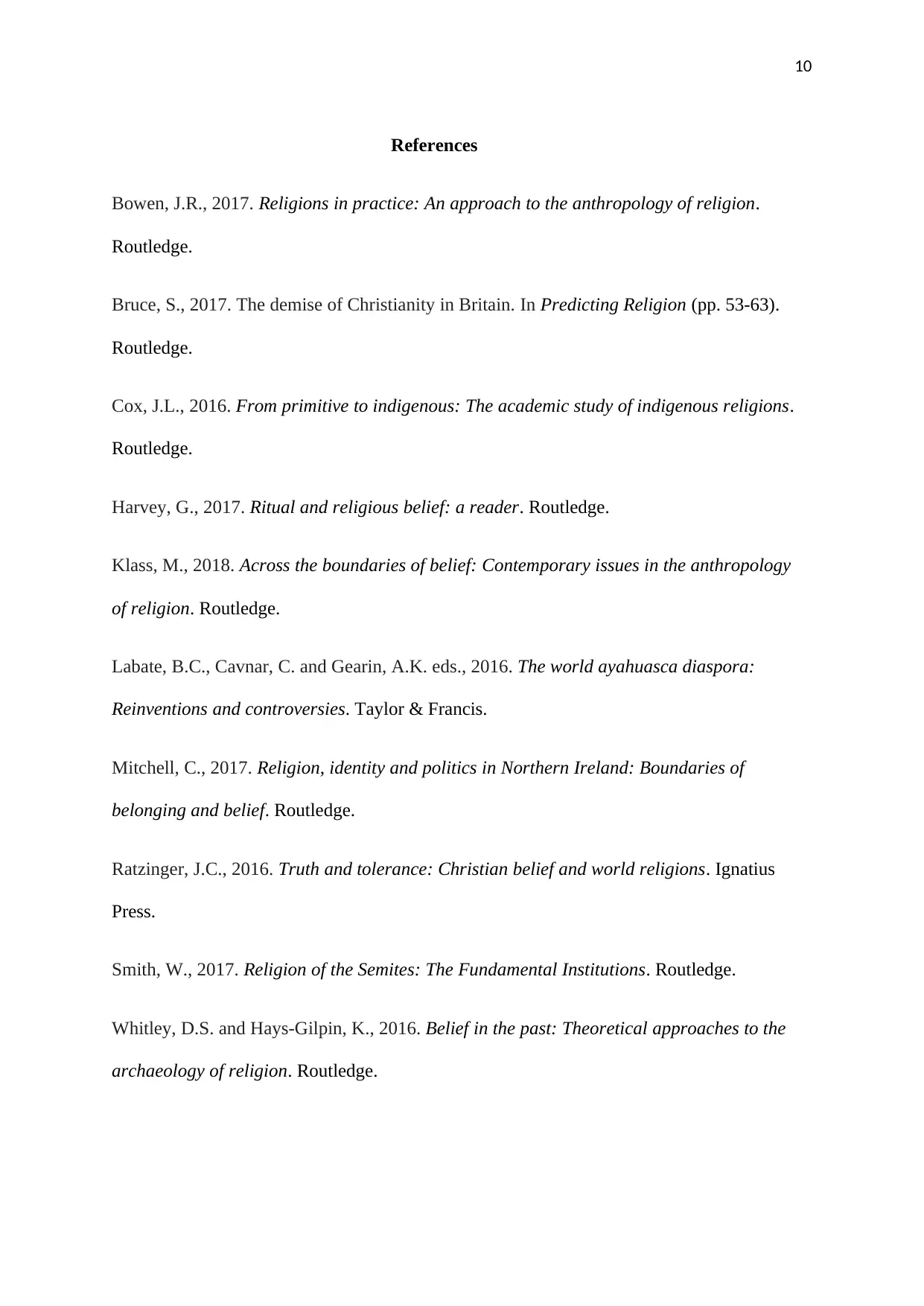
10
References
Bowen, J.R., 2017. Religions in practice: An approach to the anthropology of religion.
Routledge.
Bruce, S., 2017. The demise of Christianity in Britain. In Predicting Religion (pp. 53-63).
Routledge.
Cox, J.L., 2016. From primitive to indigenous: The academic study of indigenous religions.
Routledge.
Harvey, G., 2017. Ritual and religious belief: a reader. Routledge.
Klass, M., 2018. Across the boundaries of belief: Contemporary issues in the anthropology
of religion. Routledge.
Labate, B.C., Cavnar, C. and Gearin, A.K. eds., 2016. The world ayahuasca diaspora:
Reinventions and controversies. Taylor & Francis.
Mitchell, C., 2017. Religion, identity and politics in Northern Ireland: Boundaries of
belonging and belief. Routledge.
Ratzinger, J.C., 2016. Truth and tolerance: Christian belief and world religions. Ignatius
Press.
Smith, W., 2017. Religion of the Semites: The Fundamental Institutions. Routledge.
Whitley, D.S. and Hays-Gilpin, K., 2016. Belief in the past: Theoretical approaches to the
archaeology of religion. Routledge.
References
Bowen, J.R., 2017. Religions in practice: An approach to the anthropology of religion.
Routledge.
Bruce, S., 2017. The demise of Christianity in Britain. In Predicting Religion (pp. 53-63).
Routledge.
Cox, J.L., 2016. From primitive to indigenous: The academic study of indigenous religions.
Routledge.
Harvey, G., 2017. Ritual and religious belief: a reader. Routledge.
Klass, M., 2018. Across the boundaries of belief: Contemporary issues in the anthropology
of religion. Routledge.
Labate, B.C., Cavnar, C. and Gearin, A.K. eds., 2016. The world ayahuasca diaspora:
Reinventions and controversies. Taylor & Francis.
Mitchell, C., 2017. Religion, identity and politics in Northern Ireland: Boundaries of
belonging and belief. Routledge.
Ratzinger, J.C., 2016. Truth and tolerance: Christian belief and world religions. Ignatius
Press.
Smith, W., 2017. Religion of the Semites: The Fundamental Institutions. Routledge.
Whitley, D.S. and Hays-Gilpin, K., 2016. Belief in the past: Theoretical approaches to the
archaeology of religion. Routledge.
Paraphrase This Document
Need a fresh take? Get an instant paraphrase of this document with our AI Paraphraser

11
1 out of 11
Your All-in-One AI-Powered Toolkit for Academic Success.
+13062052269
info@desklib.com
Available 24*7 on WhatsApp / Email
![[object Object]](/_next/static/media/star-bottom.7253800d.svg)
Unlock your academic potential
Copyright © 2020–2025 A2Z Services. All Rights Reserved. Developed and managed by ZUCOL.
